Australia’s ute market is a battleground, with tradies, families, and adventurers demanding vehicles that blend toughness, comfort, and value. Enter the 2026 LDV/Maxus Terron 9, a Chinese-built dual-cab ute that’s making waves with its bold design, premium features, and a jaw-dropping price of ~$50,000 drive-away. Launched at a proving ground in 2025, this supersized ute slots between the Ford Ranger and American giants like the Ram 1500, promising more space and power than rivals like the Mitsubishi Triton and Isuzu D-Max—at a fraction of the cost. With a massive grille, a plush interior, and surprising off-road capability, it’s gone viral on X, with Aussies raving about its “insane value” and “beast of a look.” In this detailed 2026 LDV Terron 9 review, we dive into its design, performance, off-road prowess, and whether it truly outclasses the Triton and D-Max. Buckle up for a deep dive into Australia’s newest ute contender!
Quick Verdict
Rating: 4.6/5
Pros:
- Unmatched value at ~$50,000 drive-away for a feature-packed base model.
- Premium interior with soft-touch materials and dual 12.3-inch displays.
- Solid off-road capability with rear diff lock, 215–220 mm ground clearance, and multiple drive modes.
- Spacious second row and 3.5-tonne towing capacity for work or play.
Cons: - Intrusive safety systems (lane-keep, driver monitoring) distract with constant beeping.
- Sluggish acceleration at higher speeds despite strong torque.
- No cab-chassis option limits customization for some tradies.
- Unproven long-term reliability compared to Japanese rivals.
Best For: Tradies, families, and budget-conscious buyers seeking a versatile, stylish ute.
Why the LDV Terron 9 Is a Game-Changer for Australia
Utes are Australia’s lifeblood—whether hauling tools in Sydney, towing caravans to the Great Ocean Road, or tackling Outback trails. The LDV Terron 9 2026 enters this fiercely competitive market as a bold offering from LDV/Maxus, a Chinese brand gaining traction for affordable, feature-rich vehicles. Unlike the smaller LDV T60 ($38,990 drive-away), the Terron 9 is larger, more powerful, and positioned against mid-size heavyweights like the Mitsubishi Triton (~$55,000) and Isuzu D-Max (~$52,000). Its promotional price of $49,990 drive-away for ABN holders (reverting to $50,990) undercuts segment leaders, making it a compelling choice for budget-conscious buyers.
The Terron 9’s unibody design, spacious cabin, and 500+ Nm of torque aim to rival Japanese stalwarts while offering a premium experience typically reserved for pricier utes like the Ford Ranger ($50,880+). Its viral buzz on X—where users call it “the best-value ute in Oz” and love its “monster grille”—signals strong interest. But can it deliver on-road comfort, off-road grit, and long-term reliability? Let’s explore every angle, from its bold exterior to its off-road performance, and see how it stacks up against the Triton and D-Max.
Detailed Review: Unpacking the LDV Terron 9
Design & Aesthetics
The Terron 9’s design is impossible to ignore, with a front end that demands attention:
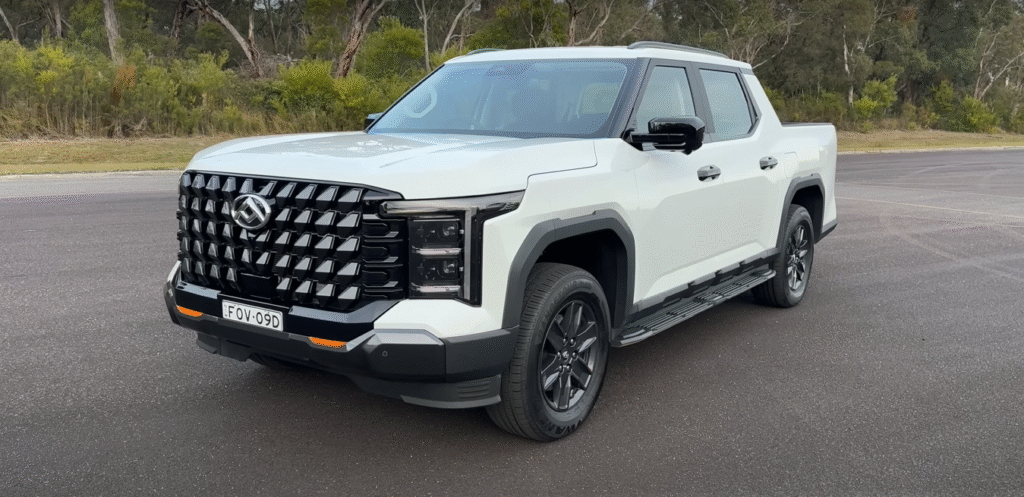

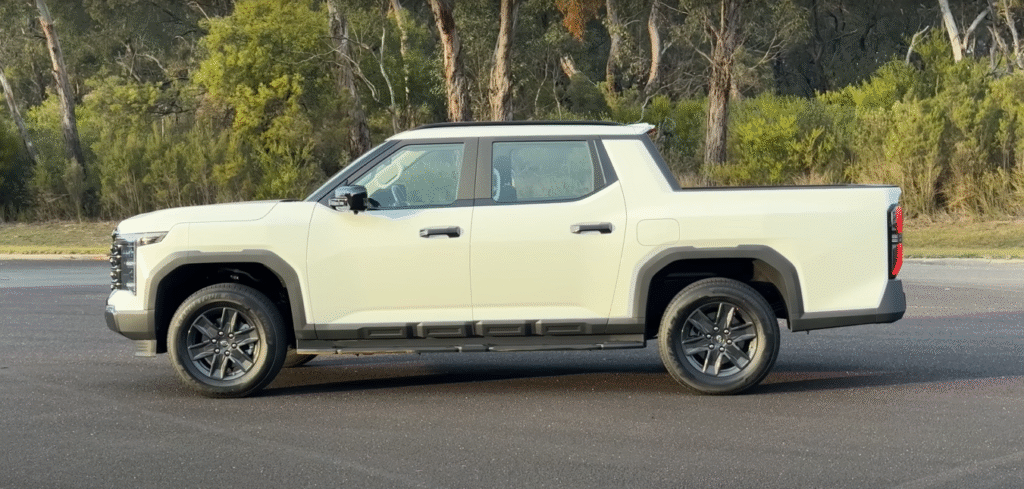
- Massive Grille: The largest grille on any 2026 ute, featuring 3D elements and a bold LDV logo. X users say, “It’s like a billboard on wheels!” Some love its bravado; others find it over-the-top.
- LED Lighting: Full LED headlights with static, parking, and regular modes, plus LED tail lights, ensure excellent visibility on rural Australian roads.
- 18-Inch Alloy Wheels: Fitted with highway-terrain tires and black wheel arch cladding, the base model balances style and off-road utility. A top-spec Evolve trim with 20-inch wheels is coming for road-focused buyers.
- Side Steps & Roof Rails: Plastic side steps feel a bit flimsy, but sturdy roof rails add practicality for carrying kayaks or camping gear.
- Tub Features: The tray includes a spray-on bed liner, hydraulic tailgate, and protective plastic trim to prevent scratches—a tradie’s dream. However, no power outlets or pre-cut accessory holes limit canopy options.
- Dimensions: At ~5.3 meters long with a 3,300 mm wheelbase, it’s larger than a Ranger (5,370 mm) but smaller than a Ram 1500 (~5.9 m).
Available in colors like white, black, and a standout orange-accented option, the Terron 9’s bold aesthetic makes it a lifestyle statement, perfect for car meets or worksite swagger.
Engine & Performance
The Terron 9’s powertrain is built for work and play:
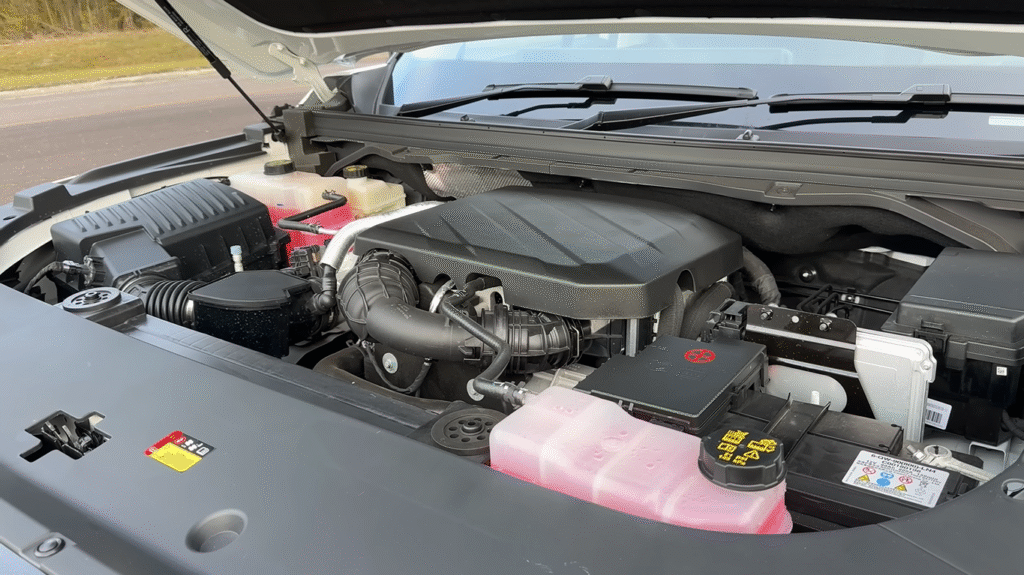
- Engine: 2.5L turbocharged 4-cylinder diesel, delivering 163 kW (218 hp) and 500+ Nm of torque—outpacing the Triton (150 kW, 470 Nm) and D-Max (140 kW, 450 Nm).
- Transmission: 8-speed torque converter automatic, smooth but not lightning-fast, prioritizing torque over rapid shifts.
- Fuel Economy: Official claim of ~7.8 L/100 km, competitive for a 2.5-tonne ute, though real-world tests are pending. For comparison, the Triton achieves 7.7–9.1 L/100 km, and the D-Max 8.0–11.9 L/100 km.
- Performance Metrics:
- 0–100 km/h: 10.82 seconds, decent but slower than the Triton’s ~10 seconds.
- 80–120 km/h: 8.91 seconds, showing a taper at higher speeds.
- 100–0 km/h Braking: 40.21 meters in 2.91 seconds, solid for a dual-cab ute.
- Reverse Speed: 37 km/h, practical for worksite maneuvers.
- Drivetrain: On-demand 4WD with low range and rear diff lock (usable in high range), engaging seamlessly with minimal slip.
The Terron 9 feels strong off the line, ideal for towing or city starts, but its 2.5-tonne mass dulls acceleration at highway speeds compared to the Triton’s punchier feel. The gearbox leans on torque, holding gears for efficiency, making it a relaxed cruiser for long drives from Melbourne to Alice Springs.
Interior & Comfort
The Terron 9’s cabin is a revelation at this price point:
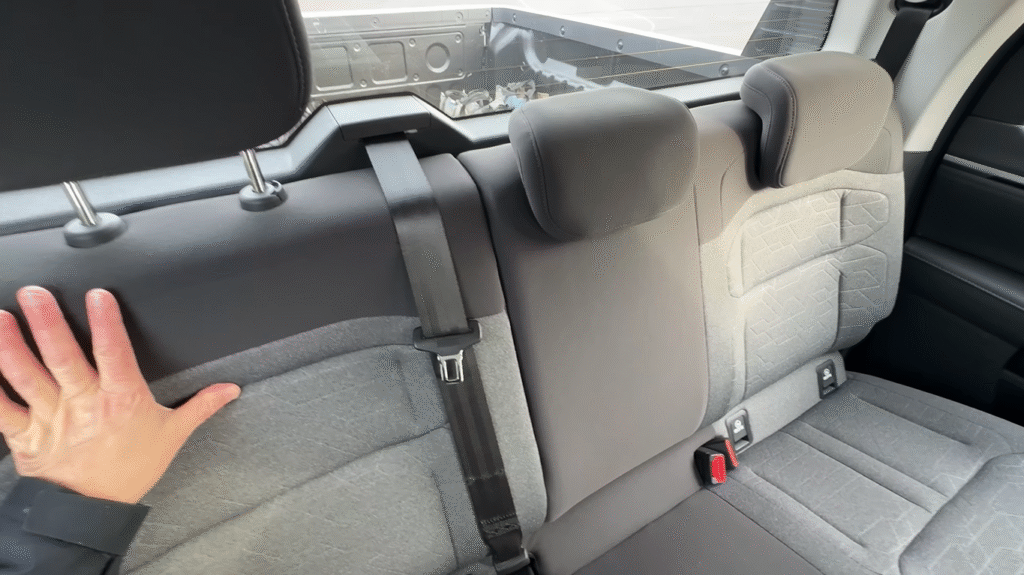
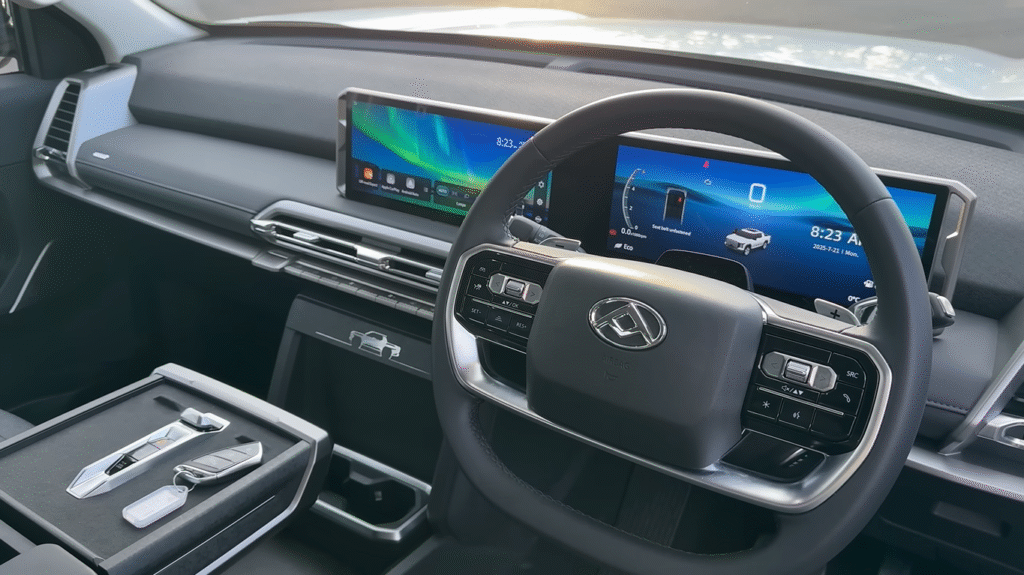
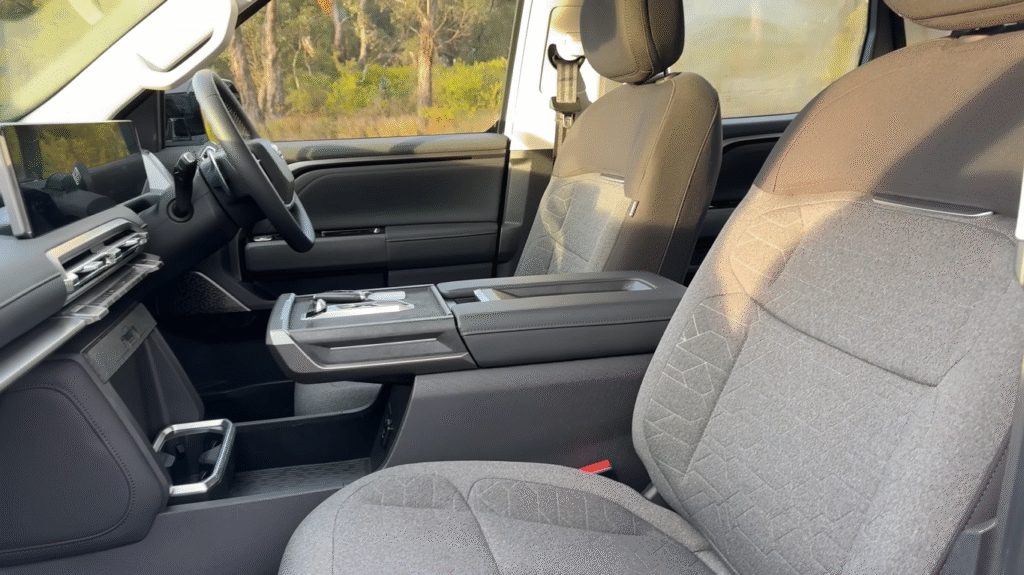
- Premium Materials: Soft-touch surfaces on the dashboard, center console, and doors rival pricier utes like the Ranger. No cheap plastics here—X users call it “luxury for tradies.”
- Dual 12.3-Inch Displays: A driver display and infotainment touchscreen offer crisp graphics, though slight lag is noticeable. Features include:
- Built-in satellite navigation (rare for base models).
- Wired/wireless Apple CarPlay and Android Auto.
- AM/FM/DAB+ radio with a 4-speaker system (average audio quality).
- Ergonomics: 8-way electric driver’s seat, tilt/reach steering, and dual-zone climate control ensure comfort. The minimalist fabric seats are durable and stylish, ideal for tradies or families.
- Storage: Large center console, cup holders, door bins, and a glove box, but no sunglasses holder or dash cam USB port. A wireless charger is missed.
- Second Row: Class-leading space with ample knee and headroom, USB-A/C ports, air vents, and map pockets. No center armrest or cup holders is a minor letdown. Windows go fully down, a rarity for utes.
- Build Quality: The door slam feels solid, but the electronic door release with traffic sensors has a poorly placed manual override, a safety concern in crashes.
The integrated unibody design boosts second-row space, making it ideal for families on road trips to the Blue Mountains or crew heading to a Perth worksite.
Technology & Safety
The Terron 9 is tech-heavy but has quirks:
- Infotainment: The 12.3-inch touchscreen is intuitive, with swipe-up home access and customizable backgrounds. Headlight controls via the screen (not a stalk) feel clunky.
- Parking Aids: Front/rear sensors and a high-resolution 360-degree camera make parking in tight Brisbane streets effortless.
- Safety Systems: Lane-keep assist and driver monitoring are overly sensitive, with incessant beeping that frustrates drivers. X users agree: “LDV needs a ‘shut-off’ button!” A one-touch disable is essential.
- Key Features: Proximity key, push-button start, hill descent control, and wade sensing (550 mm depth) enhance usability.
- Off-Road Tech: Crawl control, rock crawl mode, and a front-view camera aid off-roading, though crawl control needs refinement.
The tech package is impressive for $50,000, but the intrusive safety aids detract from the experience, a common issue in modern utes.
Practicality & Load Capacity
The Terron 9 is a true workhorse:
- Tray Dimensions: 1,600 mm long, 1,600 mm wide (1,230 mm between arches), with a 1,100 kg payload—slightly more than the Triton (935 kg) and D-Max (~1,000 kg).
- Towing: 3.5-tonne braked capacity with a factory-fitted tow bar and wiring harness, matching rivals.
- Tub Features: Spray-on bed liner, hydraulic tailgate, and tie-down hooks, but no power outlets or pre-cut accessory holes limit canopy versatility.
- Unibody Design: No cab-chassis option, a drawback for tradies needing custom trays, unlike the Triton or D-Max.
- Chassis: Leaf springs (rear) and independent front suspension balance load-carrying and comfort.
It’s built for hauling tools in Adelaide or towing boats to the Gold Coast, with enough space for family camping gear.
Ride & Handling
On the proving ground, the Terron 9’s ride surprised:
- Suspension: Leaf springs (rear) and independent front suspension deliver a balanced ride—neither too firm nor too soft. With 200 kg in the tray, it feels planted; unladen, it’s slightly bouncy.
- High-Speed Stability: At 130 km/h on sine waves, body control is decent, with minor front-end bounce but better composure than some Japanese utes.
- Rough Roads: At 90 km/h, it absorbs bumps well, handling divots without harshness, ideal for Australia’s potholed rural roads.
- Steering: Artificial weight with limited feel, adequate for a ute but not dynamic. Sport mode improves cornering for a 2.5-tonne vehicle.
- Drive Modes: Eco, Normal, Sport, Mud, Rock Crawl, Deep Snow, and Wade modes adjust throttle and traction for versatility.
The Terron 9 handles urban commutes and country roads with ease, making it a solid all-rounder for drives from Canberra to Cairns.
Off-Road Capabilities
The Terron 9 tackles light to moderate off-roading with confidence:
- Specs:
- Ground Clearance: 215 mm (laden), 220 mm (unladen), comparable to Triton (220 mm) and D-Max (240 mm).
- Approach Angle: 29°, departure angle: 25°, suitable for moderate trails but limited by rear overhang in extreme descents.
- Wading Depth: 550 mm with wade sensing, ideal for crossing shallow creeks.
- 4WD System: On-demand 4WD with low range and rear diff lock (usable in high range), engaging quickly after minimal slip.
- Drive Modes: Eco, Normal, Sport, Mud, Rock Crawl, Deep Snow, Wade.
- Off-Road Performance:
- Moguls: Struggles in Eco mode with a spinning rear wheel, but Mud mode and rear diff lock clear obstacles effortlessly. Traction control needs refinement.
- Hill Climb: Requires diff lock and momentum in low range for soft terrain; hill hold works but slips without enough throttle. Crawl control spins wheels instead of optimizing grip.
- Rock Crawl: Rock Crawl mode dulls throttle for control, with no clearance issues on moderate rocks.
- Mud Bog: Handles soft mud well with diff lock, though highway-terrain tires limit grip compared to the Triton’s all-terrain tires.
- Off-Road Tech: Wade sensing, hill descent control, and a front-view camera aid navigation, but crawl control lags behind rivals like the D-Max’s polished systems.
The Terron 9 handles light trails like those in Victoria’s High Country or Queensland’s beaches well but isn’t a hardcore off-roader like a Ranger Raptor. Upgrading to all-terrain tires on the Evolve trim could boost grip.
Comparison: LDV Terron 9 vs. Mitsubishi Triton vs. Isuzu D-Max
Here’s how the Terron 9 stacks up against the 2026 Mitsubishi Triton GLS and Isuzu D-Max LS-U+:
- Mitsubishi Triton GLS (2026):
- Price: ~$59,090 + on-roads (~$62,000 drive-away with Deluxe Pack).
- Engine: 2.4L twin-turbo diesel, 150 kW, 470 Nm.
- Payload/Towing: 935 kg, 3.5-tonne braked towing.
- Features: 9.0-inch touchscreen, wireless Apple CarPlay (wired Android Auto), 7.0-inch driver display, wireless charger, Super Select II 4WD, 7 terrain modes.
- Off-Road: 220 mm ground clearance, rear diff lock, all-terrain tires. Stronger traction control than Terron 9.
- Pros: Punchier acceleration, proven reliability, better dealer network.
- Cons: Smaller second row, less premium interior, higher price.
- Isuzu D-Max LS-U+ (2026):
- Price: ~$65,000 + on-roads (~$68,000 drive-away).
- Engine: 3.0L diesel, 140 kW, 450 Nm.
- Payload/Towing: ~1,000 kg, 3.5-tonne braked towing.
- Features: 9.0-inch touchscreen, wireless Apple CarPlay/Android Auto, 7.0-inch driver display, auto walk-away locking, off-road display.
- Off-Road: 240 mm ground clearance, rear diff lock, all-terrain tires. Polished traction and crawl control.
- Pros: Rugged durability, refined ride, strong resale value.
- Cons: Dated tech, less spacious cabin, priciest of the trio.
- LDV Terron 9 Origin (2026):
- Price: $49,990 drive-away (ABN holders, promotional).
- Engine: 2.5L diesel, 163 kW, 500+ Nm.
- Payload/Towing: 1,100 kg, 3.5-tonne braked towing.
- Features: Dual 12.3-inch displays, wireless Apple CarPlay/Android Auto, 360-degree camera, wade sensing.
- Off-Road: 215–220 mm ground clearance, rear diff lock, highway-terrain tires. Weaker crawl control.
- Pros: Best value, plush cabin, spacious second row.
- Cons: Unproven reliability, intrusive safety tech, no cab-chassis.
Verdict: The Terron 9 wins on price, cabin space, and features, making it ideal for budget buyers or families. The Triton offers sharper performance and reliability, while the D-Max excels in off-road refinement and resale value. For hardcore off-roaders, the D-Max’s traction control and tires edge out; for value and comfort, the Terron 9 shines.
Pros and Cons
Pros:
- Unbeatable $49,990 drive-away price for a feature-rich ute.
- Luxurious interior with soft-touch materials and large displays.
- Spacious second row for families or crew.
- Solid off-road capability with rear diff lock and 550 mm wading depth.
- 1,100 kg payload and 3.5-tonne towing for work or adventure.
Cons: - Overzealous safety systems distract with constant beeping.
- Sluggish at higher speeds despite strong low-end torque.
- No cab-chassis option limits tradie customization.
- Unproven long-term reliability and weaker resale value.
- Crawl control and traction control need refinement for off-roading.
Verdict
The 2026 LDV/Maxus Terron 9 is a bold contender in Australia’s ute market, offering unmatched value at $49,990 drive-away. Its premium interior, spacious cabin, and 500+ Nm of torque rival pricier utes like the Mitsubishi Triton and Isuzu D-Max, while its bold grille and customization options make it a lifestyle standout. Off-road, it handles light trails with ease thanks to a rear diff lock and multiple drive modes, though its crawl control and highway-terrain tires lag behind rivals. The intrusive safety tech is a frustration, and long-term reliability remains unproven, with X users asking, “Will it last like a Toyota?” For tradies, families, or adventurers seeking a budget-friendly yet capable ute, the Terron 9 is a compelling choice that outshines the Triton and D-Max on value and comfort. Test drive it at an LDV dealer and share your thoughts on X with #LDVTerron9!
The LDV Terron 9 features a unibody design, meaning there is no traditional gap between the cabin and the tub, which contributes to more interior and tub space.
The 2026 LDV Terron 9 is powered by a 2.5-liter 4-cylinder single turbo diesel engine, producing 163 kW of power and 520 Nm of torque, paired with an 8-speed ZF automatic transmission.
The LDV Terron 9 offers a strong 3.5-ton braked towing capacity and a payload of over 1,000 kg for all available versions.
No, the LDV Terron 9 does not require AdBlue, which can be a convenience for some users.
As of this review, the LDV Terron 9 has not yet received an ANCAP safety rating, though a related model, the MG U9, has a five-star Euro NCAP rating.
Real-World Use Cases
- Tradie Work: The 1,100 kg payload and 3.5-tonne towing capacity handle tools, trailers, or machinery on Perth worksites.
- Family Adventures: The spacious second row and premium cabin make road trips to Uluru or the Great Ocean Road comfortable.
- Light Off-Roading: Tackles Outback tracks or coastal trails, though all-terrain tires are recommended for better grip.
- Lifestyle Appeal: The bold grille and modern tech shine at car meets or rural shows in Queensland.
X Buzz: What Aussies Are Saying
On X, the Terron 9 is a hot topic: “$50K for that cabin and power? LDV’s stealing the show! #Terron9.” Others love its design: “That grille is a statement—best-looking ute under $60K.” Some caution about reliability: “Looks awesome, but will it hold up like a D-Max?” The excitement is palpable, with Aussies eager to see it in showrooms.
About LDV in Australia
LDV, part of Chinese giant SAIC, is carving a niche in Australia with value-driven vehicles. The Terron 9, alongside the T60 and upcoming MG U9 (a near-identical twin), shows LDV’s commitment to the ute market. With a 7-year, 200,000 km warranty but no capped-price servicing, buyers should weigh long-term costs.
Top 10 Reasons to Buy the 2026 LDV Terron 9
Top 5 Reasons to Think Twice Before Buying the 2026 LDV Terron 9
About the Author & Disclosure:
About the Author: About the Author: About the Author: Reo R As a marketing expert with 4 years of experience in the digital marketing field, I specialize in SEO and help companies increase their online visibility, drive more traffic, and boost their sales. With a track record of success, I have a proven ability to improve clients’ SEO and drive sales.
Instagram- Reor
Source – LDV Terron 9 2026 review (Maxus pickup truck) – incl off-road Australia




[…] pricing strategy. While it’s positioned above LDV’s more budget-oriented T60, the Terron 9 offers a remarkable amount of vehicle for its cost. With competitive drive-away pricing, especially […]
[…] the Terron 9 offers many compelling reasons to buy, here are five key areas where it might fall short for some […]